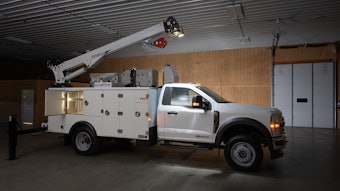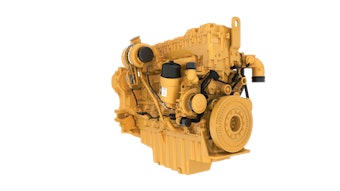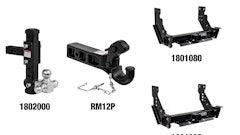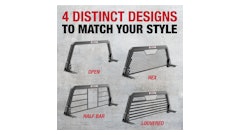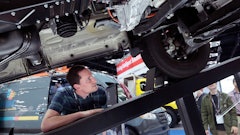
Most haul trucks come standard without a tailgate. While it might seem like a small feature, not having a tailgate often results in loads that are typically 10% to 15% below rated capacity. Though not intentional, loading a unit without a tailgate results in less material on the truck to prevent the inherent spillage out the back and over the side. Sacrificing 15% per load each trip is simply not affordable.
It costs relatively the same amount of money in labor, fuel and wear on a truck to haul a half full load as it does a load filled to capacity. By allowing for volume increases to meet the truck’s rated capacity, tailgates quickly and easily boost an operation’s profitability. For example, a 70-ton-capacity truck with a tailgate hauls nearly 11 more tons per load than a 70-ton truck without a tailgate. If a fleet of six trucks adds 11 tons to each of their respective 12 loads per day, an additional 792 tons is hauled daily. That equates to nearly $7,049 in profits if hauling aggregates at an average of $8.90 per ton. It’s like adding another truck to your fleet without the increase in fuel, maintenance or labor.
 Tailgates can increase load volume and jobsite productivity.Philippi-Hagenbuch
Tailgates can increase load volume and jobsite productivity.Philippi-Hagenbuch
Minimize Maintenance
For example, rigid-frame haul trucks are typically designed to carry one-third of the loaded weight on their front axle and two-thirds on the back. Dumping heavy materials toward the front puts immoderate stress on the chassis, axles, front tires, suspensions and hydraulic systems.
Front tires only support so much weight before they blow or rim damage occurs. Sometimes tires can be salvaged, patched or re-treaded, but even repairs are expensive, costing up to 60% of their original cost. An optimized loading target, equalized weight distribution and reduced spillage means that trucks with tailgates can extend a tire’s service life by as much as 40% or up to 13,000 hours in some cases.
But it’s important to remember that just because a truck has a tailgate, that doesn’t mean it can be overloaded. A 70-ton truck cannot haul 80 tons of material without operating outside of the OEM truck manufacturers guidelines; this can cause damage and safety hazards in addition to voiding the truck warranty. Squeezing an extra 10 tons in a load might seem like a quick way to bring in extra profits; however, repair costs far exceed the additional revenue if you blow a tire or cripple the chassis and axles.
 The large tires found on off-highway haul trucks are not cheap to repair or replace after damage occurs. Adding a tailgate can reduce that expense and downtime.Philippi-Hagenbuch
The large tires found on off-highway haul trucks are not cheap to repair or replace after damage occurs. Adding a tailgate can reduce that expense and downtime.Philippi-Hagenbuch
Navigating the debris can damage tires as well as a truck’s suspension systems. In some large mines, for example, more than 200 tires are replaced per month because of debris damage or overloading. Many businesses aren’t equipped to handle the type of negative impact tire damage can have on overall profitability, especially since the cost of rubber has gone up by 250% since 2009.
What Options Are There?
It doesn’t take long to put pencil to paper and figure out that adding a tailgate enhances profitability, but the decision is not that simple. With a variety of tailgate options on the market, it’s important to find the design that complements the specific operation.
A tailgate enhances operations whether you’re hauling aggregates, coal, iron, fly ash, oil sands or soupy, viscous materials. But there are a couple of design aspects to look for before making a purchase decision, such as durability and versatility.
First and foremost, work with a manufacturer that makes a customizable tailgate for any truck body. Then, find a tailgate that lifts instead of drops down for maximum efficiency. A dropdown tailgate is sometimes slower when opening and closing and is more susceptible to damage from the dumped materials. These designs often rely on pins or hydraulic systems, and when there are more grease points, cylinders and joints, the risk of failure increases. They might seem like quick, economical solutions, but dropdown tailgates end up costing more for repairs and replacement in the long run.
Ultimately, a lifting, scissor-style tailgate has fewer moving parts so there’s less potential maintenance. But having fewer moving parts isn’t everything. Be sure these few parts are tough enough for the job. A tailgate won’t last long if it can’t withstand the breadth of material being hauled. Find a tailgate that’s built with durable materials, such as high-strength steel, and features strong components including steel alloy chains and bushings that don't require ongoing lubrication.
 It’s important to find a tailgate that lifts high enough to avoid damage and carryback.Philippi-Hagenbuch
It’s important to find a tailgate that lifts high enough to avoid damage and carryback.Philippi-Hagenbuch
Adding cushion pads to a tailgate will soften the blow when it is raised and lowered in harsh worksite conditions. When operations have extremely bouncy haul roads, the cushion pads minimize noise and increase the service life of the tailgate and other truck components.
Operations that haul large amounts of wet material arguably need a tailgate more than any other operation that uses off-highway haul trucks. In these applications, a tailgate with a fluidic seal can create a near-perfect seal, resulting in minimal fluid leakage during transport. While it is impossible to contain 100% of the liquid material, it is not uncommon to decrease wet material spillage by up to 99.5% when a truly engineered solution is implemented.
Lastly, make sure the tailgate lifts high and fast enough to get out of the way before unloading. The last thing you want is the tailgate to hold back the load during dumping rather than allowing it to flow freely out of the back of the truck body. Fast dumps lead to increased efficiency and productivity. Materials left behind in the bed or stuck in grease points damage hinges and overall structure, and the amount of carryback reduces the volume of the next load.
ROI and Beyond
The return on investment associated with a tailgate is significant, and scissor-style tailgates take it even further. From increased volume and reduced maintenance to fast load dumping and safe operations, an off-highway tailgate quickly pays for itself, even with the average cost between $18,000 to $28,000, based on the size of haul truck and options chosen.
Consider that six 70-ton-capacity trucks hauling aggregates bringing in approximately $7,490 in additional profits per day will start seeing an ROI on the purchase of the six tailgates after 22 days from the volume boost alone, not to mention the additional fuel and tire cost savings associated with the addition of tailgates to a truck fleet.
And when it comes to profits, who doesn’t want more?
Josh Swank is vice president of sales and marketing, Philippi-Hagenbuch, Inc.




